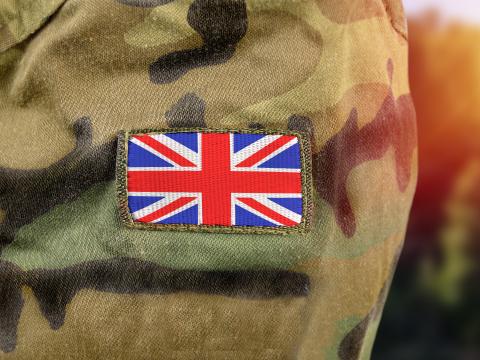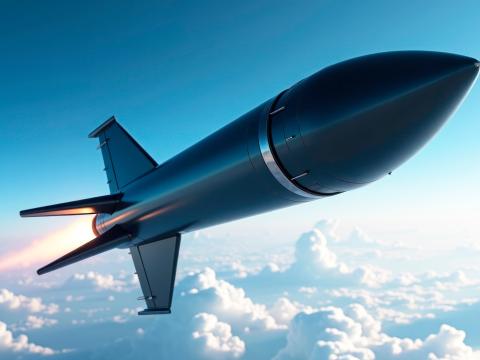Mobile Laser Offers Tactical Defense
Incoming missiles, artillery shells and aircraft may fear the beam.
The long-sought dream of using lasers to defend against an enemy on a battlefield may be closer to realization, if recent tests in the New Mexico desert can be transitioned successfully into a tactical system. The U.S. Army is aiming to begin development next year of a prototype that would be ready in 2007 to defend against targets ranging from cruise missiles to incoming artillery shells.
The device would be an easily transportable, mobile version of a high-energy laser that has brought down several types of airborne targets in various tests over the past few years. Known as the mobile tactical high-energy laser, or MTHEL, this future battlefield weapon is being designed to destroy cruise missiles, unmanned aerial vehicles, very-short-range ballistic missiles, mortar shells, ground- and air-launched rockets and artillery projectiles.
No major technology challenges remain for developing this mobile tactical laser. The only hurdles to be overcome are in the engineering that would transform a desert testbed into a viable battlefield system. Northrop Grumman Space Technology, Redondo Beach, California, is heading a development team that includes several U.S. and Israeli high-technology firms. The Army has selected their design concept as the baseline for the future mobile battlefield laser system.
Dr. Josef Shwartz, Northrop Grumman program manager for MTHEL, relates that this system builds on several years’ work performed by TRW engineers before their company was acquired by Northrop Grumman. Their efforts were complemented by those of Israeli scientists who worked with their U.S. counterparts beginning in the early 1990s. Israel’s main concern then was frequent attacks by enemies firing Katyusha rockets from southern Lebanon into northern Israel. The U.S. Army initiated the cooperative effort, which began with a feasibility study in 1995, to bring various enabling technologies in both nations together into a deployable laser system under the heading the Nautilus Project. The MIRACL, or mid-infrared advanced chemical laser—tested at White Sands Missile Range, New Mexico—was an outgrowth of that research and is a progenitor of the MTHEL system.
Shwartz explains that a workable system must detect the launch of an attacking rocket, track it with a high degree of precision and keep a powerful laser beam that is only a few inches in diameter locked on the incoming warhead. The technology breakthroughs that are enabling MTHEL development occurred some time ago, he notes.
The White Sands work evolved into the tactical high-energy laser, or THEL. In June 2000, a THEL laser shot down its first rocket. Since that test, the THEL advanced concept technology demonstrator has shot down more than 25 Katyusha rockets, some in salvos, as well as other targets. An iteration designated the MTHEL testbed has been operating at White Sands since 2002. It also has destroyed artillery shells in flight.
MTHEL employs a steady-state deuterium-fluoride (DF) laser to destroy its targets. All of the laser’s optics—both the lasing system and the pointer-tracker subsystem—employ very low absorption optical coatings. The result is that these optics absorb very little heat, which eliminates the need for active cooling systems. Shwartz states that this represents the first use of a high-energy laser system without a single water-cooled mirror.
These MTHEL optics, unlike those of some other military lasers under development, are not adaptive. Engineers have turned to adaptive optics to help some lasers overcome the problems posed by atmospheric distortion. Shwartz explains that MTHEL does not face the same problems of those other lasers because of the nature of its use.
Conceding that the atmosphere does affect the beam, Shwartz states that its effect is not enough to degrade the beam below a level of effectiveness. Atmospheric absorption can both reduce the power propagated at the target and effectively create an atmospheric lens that distorts the beam. The DF laser generates a beam with a wavelength of 3.8 microns, and it suffers relatively little absorption in the atmosphere. The longer wavelength also is less susceptible to effects from atmospheric turbulence.
Another aspect that reduces atmospheric distortion involves the beam’s activity. MTHEL’s steady beam sweeps across the sky as it tracks its incoming target. This constant movement reduces the beam’s effect on the air, as its passage through fresh stretches of air minimizes its contact with a specific section of the atmosphere. The beam does not linger in one direction long enough to generate substantial atmospheric effects.
MTHEL consists of three subsystems, each of which includes several elements. The first subsystem handles MTHEL’s command, control, communications and intelligence (C3I). This subsystem controls all the radar assembly, laser subsystem and pointer-tracker subsystem operations. It manages the full engagement, including searching the extended threat zone, detecting and classifying aerial targets in its range, radiating and destroying the designated targets and providing kill assessment. The two people in the C3I subsystem crew—a commander and a gunner—are the only personnel needed to run the entire MTHEL system.
The C3I subsystem comprises four assemblies: the fire control radar, the radar communications assembly, the tactical command assembly and the fire control assembly. The fire control radar continuously searches the threat zone, performs standard detection and identification, and sends data to the radar communications assembly. This assembly in turn controls the radar and reports its tracked objects and their vectors to the tactical command assembly.
The tactical command assembly sets up the C3I subsystem configuration and provides initialization parameters for the fire control radar and the fire control assembly. It selects the targets to be engaged and determines threat engagement priorities. This assembly also collects system status data and monitors the laser and pointer-tracker subsystems. The fire control assembly, which receives the threat target information, controls the laser subsystem and the pointer-tracker subsystem during acquisition and engagement. It also provides the commander with vital information such as target and kill-assessment data during the engagement, a direct video feed from the pointer-tracker subsystem and track lock or loss data.
The C3I subsystem can operate in three modes. A fully automatic mode engages and destroys a target without any human involvement other than visual target identification, and the commander or the gunner can override firing or skip a target. A semiautomatic mode performs all functions automatically except actual firing, which must be authorized manually by the commander. And, in a manual mode, the commander both designates the target and issues the firing command.
Shwartz notes that the major difference between the MTHEL’s C3I subsystem and that of a conventional area air defense system is the reaction speed. The speed-of-light interception system needs a commensurate C3I subsystem, which leaves little time for human decision making at every step. The need to have this fast response time is why the C3I subsystem is so automated, he observes.
Most of the C3I subsystem’s computers are not system-specific. Even most of the software algorithms are the same as those in other air defense systems. However, some improved algorithms have enabled the laser system to meet its goals.
The second subsystem is the DF laser itself. To fire it, nitrogen trifluoride (NF3) and ethylene (C2H4) are reacted in multiple, side-by-side high-pressure combustion chambers using an oxidizer-rich mixture that generates free fluorine atoms. The fluorine atoms are mixed with a helium diluent and deuterium to generate DF in an excited state. A negative branch unstable resonator enhances the stimulated emission of radiation in the laser cavity to extract the continuous-wave collimated laser beam that is generated against incoming targets.
The laser subsystem consists of four assemblies: the fluid supply assembly, the gain generator assembly, the pressure recovery assembly and the laser optics assembly. The fluid supply assembly provides all reactants and other fluids for laser operation, including cooling water and hydrogen peroxide needed to run the pressure recovery assembly. The gain generator assembly orchestrates the chemical combustion that pumps the laser. It consists of 44 individual NF3 and C2H4 combustion chambers, each of which feeds an expansion nozzle that leads into the laser cavity. This assembly also includes a fluorine (F2) gas generator that ignites the NF3 and C2H4 mixture.
The pressure recovery assembly exhausts the spent gases from the laser cavity, which operates at a subatmospheric pressure. A passive diffuser, a heat exchanger and a hydrogen-peroxide-driven ejector pump work to perform this function. The fourth assembly comprises the laser optics, and it includes all the laser mirrors and their supporting structures and elements.
The third key MTHEL element is its pointer-tracker subsystem. This subsystem acquires the designated target from the fire control radar and then transmits the laser beam to the target. It also focuses the beam on the target and keeps it there until the target is destroyed. This subsystem comprises the beam director assembly, the beam alignment and stabilization assembly, the off-axis tracker, the shared aperture tracker and the pointer-tracker subsystem controller. The beam director assembly takes a 10-centimeter-diameter laser beam and expands it by a factor of seven to improve beam focusing and intensity. A three-gimbal pointing system provides targeting accuracy.
Once the C3I subsystem generates a target state vector, the pointer-tracker subsystem controller commands the beam director assembly to slew to the target. The off-axis tracker, which is a wide-field-of-view, low-resolution infrared tracker, acquires the target and steers the beam director assembly to maintain the target in the center of its field of view. The shared aperture tracker, which is a narrow-field-of-view, high-resolution tracker, can see this centered target. It takes over the targeting tracking function from the off-axis tracker and directs the laser to the selected aim point.
One of the engineering hurdles involves converting this fully integrated THEL laser system into a transportable unit, Shwartz reveals. The optical system has to be ruggedized so that it could survive the rigors of battlefield transportation. Its support infrastructure has to be portable as well as usable by operating personnel in the field.
Compacting the size of the whole system, especially the laser, remains the biggest challenge facing MTHEL engineers. One recent technological advance may prove key to solving that problem. Last year, engineers developed a new laser head that is much more compact and effective, Shwartz relates. This may enable the transition from a larger static system to a smaller laser that can be mounted on a truck. Other work focuses on making the beam director more compact and rugged.
This smaller, more efficient laser head also uses less lasing fuel, which is an important issue in a military deployment. Currently, one magazine will provide about 20 to 30 shots, depending on the type of target and the length of engagement. Reloading fuel in a battlefield environment could prove difficult. Shwartz reports that engineers are working on developing fuel containers that use flexible hoses to plug into the system. When a container is empty it would be detached and discarded, and then replaced with another fuel magazine.
Engineers also see the possibility of better and faster communications, especially if the amount of bandwidth increases. This might open the door to higher data rates. However, existing devices can provide the necessary support for MTHEL, Shwartz reiterates.
The U.S. Army has not yet placed any requirements or directions for interoperation with the Future Combat Systems (FCS) effort currently under development (SIGNAL, November 2002, page 39). Shwartz does anticipate that the Army may want to move MTHEL toward FCS compatibility in the future, however.
Shwartz declares that from the day of a contract award the company can produce a fully integrated and checked-out system within four years. The U.S. Army has earmarked $118 million for a development effort that would culminate in a working version in 2007. This budget could be supplemented by funding from the Israeli Ministry of Defense if both countries agree to a combined development program.



Comments